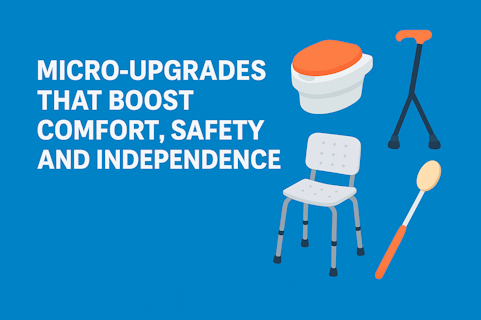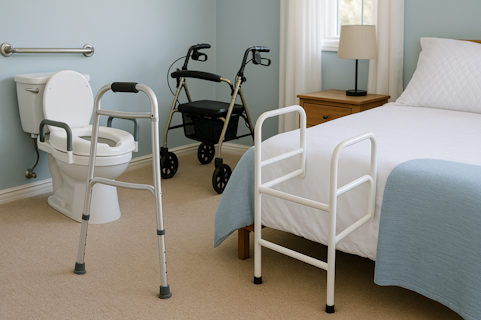
05 Dec 2025
For Help and Advice call: 01524 888453
Our blog20 May 2025
Living with arthritis can transform everyday tasks into painful challenges, particularly for the estimated 10 million people in the UK affected by this condition. For those with arthritis in their hands, simple actions like fastening buttons on a shirt can feel daunting, straining inflamed joints and sapping independence. Enter the button hook, a small but revolutionary tool among independent living aids that is transforming daily life for arthritis sufferers. This blog post explores how button hooks alleviate strain, shares real-life stories from patients, and compares features like plastic and wooden handles to highlight their role in reducing joint pain.
Button hooks are simple devices designed to assist with fastening buttons, particularly for those with limited dexterity due to arthritis. They work by looping a small hook through a buttonhole, grasping the button, and pulling it through with minimal finger movement. This reduces the need for pinching or gripping, which can exacerbate pain in joints affected by osteoarthritis or rheumatoid arthritis.
The Arthritis Research UK Foundation notes that over 50% of arthritis patients experience hand pain, making tools like button hooks essential for maintaining autonomy. By eliminating the fine motor skills required for buttoning, these devices reduce strain on inflamed joints, decrease fatigue, and prevent flare-ups. Occupational therapists often recommend button hooks as part of a broader strategy to manage daily tasks, alongside aids like jar openers and adaptive cutlery.
The impact of button hooks is best illustrated through the experiences of those who use them:
Clare, 62: Clare, a retired teacher with rheumatoid arthritis, struggled with dressing for years. “Buttoning my blouse was agony, my fingers just wouldn’t cooperate, and it left me frustrated,” she says. After her occupational therapist recommended a button hook, Clare’s routine changed. “I got a lightweight plastic-handled one, and it’s been a lifesaver. I can dress for church or a day out in Islington without pain or needing my husband’s help.” Clare’s story highlights how button hooks restore dignity and independence, allowing her to maintain her active lifestyle.
Amir, 55: Amir, a former chef with osteoarthritis, found his hand pain worsened after years of repetitive kitchen work. “I couldn’t button my jacket without wincing, and it made me feel helpless,” he shares. A friend suggested a wooden-handled button hook, which Amir found easier to grip. “It’s sturdy and feels good in my hand. I can get ready for walks along the Southbank without stressing my joints.” Amir’s experience underscores how button hooks can reduce physical and emotional strain for arthritis sufferers.
These stories reflect a broader trend. According to a 2024 survey by Disability Rights UK, 68% of arthritis patients using adaptive dressing aids reported improved quality of life, with button hooks frequently cited as a top tool.
Not all button hooks are created equal, and choosing the right one can make a significant difference for arthritis sufferers. Below, we compare key features, focusing on handle material and their impact on joint pain:
Plastic handles
Wooden handles
Other features to consider:
Both handle types reduce joint strain by minimising finger movement, but the choice depends on individual needs. Occupational therapists often suggest trying both to find the best fit, with many retailers offering VAT exemptions for disabled users, making these tools more accessible.
Button hooks are more than a convenience, they’re a critical tool for managing arthritis symptoms. By reducing the need for repetitive pinching motions, they lower the risk of joint inflammation and pain flare-ups. A 2023 study published in the British Journal of Rheumatology found that adaptive tools like button hooks decreased hand strain by up to 40% in osteoarthritis patients, allowing them to perform daily tasks with less discomfort.
Button hooks save time and energy. They also promote psychological well-being by fostering independence, reducing reliance on carers, and boosting confidence. As Clare puts it, “I feel like I’m in control again, not my arthritis.”
If you’re considering a button hook, consult an occupational therapist or GP to ensure it suits your needs
To use a button hook effectively:
Button hooks are a game-changer for arthritis sufferers, offering a simple yet effective way to reduce joint pain and reclaim independence in daily dressing. Whether you opt for a lightweight plastic model or a sturdy wooden one, these tools empower users to navigate life’s challenges with less discomfort. Stories like Clare’s and Amir’s highlight their transformative impact. If arthritis is making dressing difficult, a button hook could be your key to greater comfort and autonomy. Explore your options today and take the first step towards a pain-free routine.
05 Dec 2025
27 Nov 2025
11 Nov 2025

